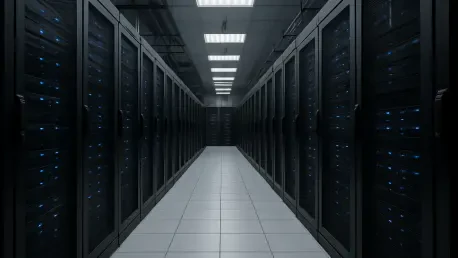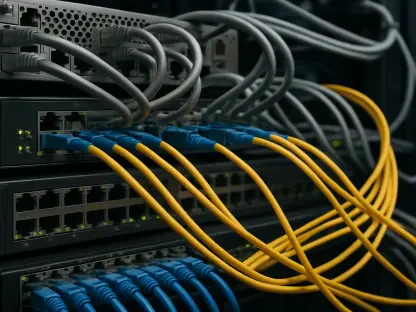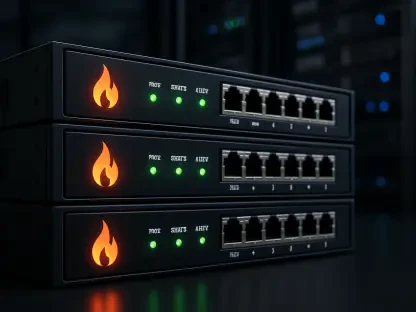In the rapidly advancing realm of digital infrastructure, data centers stand as the critical backbone supporting everything from cloud services to enterprise operations, yet they face mounting pressures to deliver flawless uptime, scalability, and efficiency in an ever-demanding environment. The complexity of modern networks has skyrocketed, rendering old-school manual management practices not just inefficient but entirely unsustainable. A groundbreaking study conducted by Futurum Research in collaboration with Nokia underscores a sweeping transformation within the industry, where automation and Artificial Intelligence for IT Operations (AIOps) have shifted from being mere options to absolute necessities. This seismic change is reshaping the operational landscape of data centers, enabling them to meet the relentless demands of today’s digital ecosystem. Far from a passing fad, this move toward automated, AI-driven solutions represents a fundamental pivot, ensuring that data centers can handle intricate challenges while maintaining peak performance and reliability for businesses worldwide.
The End of Manual Management in Data Centers
The era of manual data center management has officially drawn to a close, marking a significant turning point for the industry as a whole. According to recent research, every single organization surveyed has embraced at least one form of automation, reflecting a universal recognition that manual processes are ill-equipped to address the intricacies of modern network demands. This isn’t merely a trend confined to tech giants; businesses of all sizes, from small startups to sprawling enterprises, are driven by the urgent need to manage increasingly complex systems and avert the devastating costs of downtime. The shift away from hands-on intervention toward automated solutions is a direct response to the growing scale of digital operations, where even minor errors can cascade into major disruptions. As data centers become the linchpin of digital transformation, the adoption of automation is no longer a choice but an imperative to ensure consistent performance and safeguard operational integrity across diverse sectors.
This transition signifies more than just a technological upgrade; it represents a cultural and strategic overhaul within data center operations. The complete abandonment of solely manual methods highlights a collective acknowledgment among IT leaders that human oversight alone cannot keep pace with the speed and volume of today’s data traffic. Automation offers a lifeline by minimizing the risk of human error, which can be catastrophic in environments where milliseconds matter. Beyond error reduction, automated systems provide the agility needed to adapt to fluctuating workloads and unexpected challenges, ensuring that uptime remains unbroken. For organizations managing vast networks, this move is a proactive step to maintain a competitive edge in a landscape where reliability is synonymous with success. The industry’s unanimous pivot to automation underscores a broader commitment to resilience, setting a new standard for how data centers must operate in an era defined by digital dependency.
Core Automation Practices as Operational Foundations
At the heart of modern data center management lies a suite of core automation practices that have become indispensable for maintaining efficiency and reliability. Real-time monitoring and alerting systems lead the charge, with 67% of organizations employing these tools to detect anomalies around the clock before they spiral into critical issues. Additionally, 58% of respondents utilize configuration automation platforms like Ansible and Terraform, which allow for the management of device settings through streamlined scripts rather than labor-intensive manual updates. These foundational technologies are not just conveniences; they are essential building blocks that enable data centers to operate with precision and speed. By automating routine tasks, organizations can redirect valuable human resources toward strategic initiatives, ensuring that operational workflows remain smooth even under the strain of escalating network demands.
Beyond monitoring and configuration, other vital automation practices are being widely adopted to bolster data center resilience. Over half of the surveyed organizations, specifically 54%, leverage AI and machine learning for incident detection, using sophisticated pattern recognition to pinpoint potential problems before they manifest. Meanwhile, 49% have implemented automated failover systems that instantly address link or device failures, significantly reducing the risk of service interruptions. These combined practices create a robust operational framework that not only curbs the likelihood of errors but also enhances consistency across complex environments. As data centers grapple with ever-growing data volumes and user expectations, these automation tools serve as critical mechanisms to uphold service quality. Their widespread adoption signals a maturing industry focus on proactive management, where prevention of issues takes precedence over reactive troubleshooting in sustaining seamless digital experiences.
NetOps and DevOps Redefine Network Management
The influence of software development methodologies is profoundly reshaping data center networking through the adoption of NetOps, a concept inspired by DevOps principles. Approximately 45% of organizations now manage their network configurations using version control systems like Git, treating configurations as code to enable better tracking, collaboration, and error tracing. In parallel, 44% have integrated Continuous Integration/Continuous Deployment (CI/CD) pipelines into their workflows, automating the testing and deployment of network changes to ensure both speed and accuracy. This convergence of networking and software practices introduces a level of discipline and efficiency previously unseen in traditional data center operations. By borrowing from the agility of software development, these approaches allow for rapid adaptation to changing requirements, ensuring that networks remain robust and responsive in dynamic digital environments.
Further illustrating this shift, 44% of organizations have formalized change approval workflows with role-based access controls, embedding accountability and structure into network management processes. Additionally, a third of surveyed entities have developed custom automation scripts tailored to specific operational needs, while 20% are pushing boundaries with advanced techniques like chaos engineering to test system durability under stress. These efforts reflect a growing emphasis on precision and adaptability, as data centers strive to mirror the rigor of software engineering in their networking strategies. The integration of such practices not only accelerates change implementation but also fortifies systems against potential failures. As more organizations embrace these methodologies, the line between IT operations and software development continues to blur, fostering a collaborative mindset that prioritizes innovation and reliability in equal measure within data center ecosystems.
Advanced Technologies Usher in Proactive Solutions
The frontier of data center innovation is being defined by the rapid adoption of advanced technologies such as AIOps and intent-based networking, which are swiftly transitioning from experimental concepts to standard practices. An impressive 80% of IT leaders consider pre- and post-checks for configuration changes to be critical, while 78% place high value on integrated digital twins—virtual replicas of networks used to simulate and validate changes before live deployment. Adoption statistics mirror this priority, with 59% of organizations already implementing automated configuration validation tools, and roughly half incorporating digital twins, closed-loop automation systems, and intent-based networking into their operations. These cutting-edge solutions enable a shift from reactive fixes to proactive management, allowing data centers to anticipate and mitigate issues before they impact users, thereby redefining operational excellence.
This embrace of sophisticated tools underscores a broader industry movement toward autonomous and predictive systems that can self-correct and optimize in real time. AIOps platforms, now in production at 43% of organizations with another 31% in pilot or deployment phases, exemplify this trend by harnessing AI to analyze vast datasets and predict potential disruptions. Similarly, the growing use of intent-based networking—where systems automatically align configurations with predefined business goals—demonstrates a commitment to reducing manual oversight while enhancing precision. These technologies empower data centers to handle complexity at scale, ensuring that performance remains consistent even as demands intensify. As adoption rates climb, it’s evident that such advanced tools are not mere luxuries but strategic investments in future-proofing operations, positioning organizations to thrive in an increasingly intricate and fast-paced digital landscape.
Strategic Drivers Fueling the Automation Movement
The relentless push toward automation and AIOps in data centers transcends mere operational convenience, emerging instead as a strategic imperative to address critical challenges. Minimizing human error stands as a primary motivator, given that even small mistakes can lead to significant disruptions in high-stakes environments. Equally important is the need to accelerate response times, as delays in addressing issues can translate into substantial financial losses and reputational damage. Automation technologies, by streamlining processes and enabling rapid intervention, directly tackle these risks, ensuring that data centers can maintain service continuity under pressure. This strategic focus on error reduction and speed is reshaping priorities, with IT leaders recognizing that robust automation is essential for safeguarding both operational stability and business outcomes in a competitive market.
Central to this strategic vision is the concept of an “intelligent automation loop,” which integrates monitoring, testing, CI/CD pipelines, and AI-driven analytics to continuously validate network performance against intended goals. This holistic approach not only detects anomalies in real time but also automates corrective actions, creating a self-sustaining cycle of improvement that enhances uptime and reliability. Such systems are particularly vital in environments where downtime is not an option, as they provide a proactive defense against potential failures. By embedding intelligence into every layer of operations, data centers can achieve a level of consistency that manual processes could never match. This strategic alignment of technology with business needs highlights why automation and AIOps are viewed as indispensable tools for scaling operations and maintaining trust in an era where digital reliability is paramount to organizational success.
Automation Becomes the Industry Standard
Across the data center landscape, a resounding consensus has emerged: automation and AI-driven operations are no longer fringe innovations but fundamental components of effective management. The fact that 100% of surveyed organizations employ at least one automation tool, with the majority utilizing multiple solutions, speaks volumes about the technology’s integration into mainstream practice. This universal adoption reflects an industry-wide pivot where manual processes are deemed obsolete in the face of modern network scale and complexity. IT leaders increasingly view these tools as critical levers for ensuring scalability and service continuity, particularly in environments where even brief outages can trigger severe consequences. Automation’s status as a standard is a testament to its proven ability to enhance efficiency and reliability across diverse operational contexts.
This industry shift also reveals a deeper understanding of automation’s role in strategic planning. Far from being a mere tactical fix, automated systems are recognized as essential for managing the exponential growth of data and user expectations that define today’s digital economy. The widespread use of multiple tools indicates a layered approach, where organizations combine monitoring, configuration management, and AI analytics to build resilient infrastructures. Such comprehensive strategies enable data centers to adapt to sudden spikes in demand or unforeseen challenges without compromising performance. As automation cements its place as the norm, it sets a benchmark for operational excellence, compelling even late adopters to rethink their approaches. This collective move toward automated solutions signals an industry unified in its pursuit of innovation, where staying ahead means embracing technology as the foundation of sustainable growth and competitive advantage.
Rapid Mainstreaming of Cutting-Edge Innovations
Technologies once regarded as experimental are now gaining widespread acceptance, marking a significant democratization of advanced tools within data center operations. Self-healing networks, adopted by 33% of organizations, and intent-based networking, implemented by 50%, are swiftly moving from pilot stages to full production environments. This accelerated uptake highlights the tangible benefits these innovations deliver, such as reduced error rates and heightened operational efficiency, making them accessible to a broader range of players in the field. What was once the domain of pioneering tech leaders is increasingly becoming a standard expectation, as organizations of varying sizes recognize the value of proactive and autonomous systems in maintaining network integrity amidst growing complexities.
This mainstreaming of cutting-edge solutions reflects an industry eager to capitalize on advancements that promise long-term stability and performance gains. The transition of tools like AIOps platforms and digital twins into everyday use demonstrates a maturing market where innovation is no longer a barrier but a shared resource. Organizations adopting these technologies are better positioned to anticipate disruptions and automate responses, significantly lowering the risk of downtime. Moreover, the growing accessibility of such tools fosters a competitive environment where staying current with technological progress is crucial for relevance. As adoption continues to expand, it’s clear that these once-novel solutions are reshaping the operational playbook, establishing a new baseline for what constitutes effective data center management in a digitally driven world.
Looking Back at a Transformative Shift
Reflecting on the journey, data centers underwent a remarkable evolution as they shed the constraints of manual management and embraced automation and AIOps with open arms. Core practices like real-time monitoring and configuration automation laid the groundwork, while advanced tools such as digital twins and intent-based networking pushed the boundaries of what was possible. The industry’s unified commitment to these technologies was evident in their universal adoption, driven by the pressing need to ensure reliability and scalability in an unforgiving digital landscape. IT leaders recognized that staying competitive hinged on integrating intelligent systems that could predict and prevent issues before they arose. This transformative shift redefined operational standards, proving that automation was not just a tool but the very foundation of modern data center success.
Moving forward, the focus for data center operators and CIOs lies in deepening this automation-first approach to tackle emerging challenges. Exploring the full potential of AIOps to create truly autonomous systems should be a priority, alongside investing in training to ensure teams can leverage these tools effectively. Collaboration across the industry to share best practices could accelerate innovation, while continuous evaluation of new technologies will be key to staying ahead of evolving demands. The path ahead involves not just adopting automation but refining it to build resilient, adaptive infrastructures capable of supporting the next wave of digital growth. This ongoing commitment to technological advancement will ensure that data centers remain the steadfast pillars of a connected world, ready to meet future complexities with confidence and precision.









